
Written by guest blogger, Travis Crowder
On 9/15/22, we were honored that our good friend, Linda Rief, returned to our #G2Great guest host seat to discuss her incredible new book, Whispering in the Wind: A Guide to Deeper Reading and Writing Through Poetry (Heinemann, 2022) following a previous #G2Great chat on her book Read, Write, Teach: Choice and Challenge in the Reading Writing Workshop (Heinemann, 2014). We were also honored that our friend, teacher and writer Travis Crowder wrote this beautifully reflective blog post. Travis describes himself as a Reader. Writer. Teacher. Learner and author of Reflective Readers: The Power of Readers Notebooks. He blogs and is currently a Doctoral student at UNCW. We are so grateful to bring these two dedicated and thoughtful minds together:
Travis Crowder Reflections on Whispering in the Wind
“Stafford didn’t read his words—he spoke them. He delivered his poetry, simple but elegant words, riding on his voice and cupped in his hands as if saying, ‘Here, peek in, look what I noticed that I want you to notice. Feel what I felt at that moment. Taste these words in your mouth and feel how they slip right through to your heart” (Rief, 2022, p. 2).
“His [Stafford’s] voice said, ‘Here, take these words. Make them yours’” (Rief, 2022, p. 3).
NCTE. Atlanta. 2016.
I scanned the event program, looking for names I recognized and topics of interest. I recognized Linda Rief’s name amidst a row of others. Seeking Diversity, Linda’s first book, gave deeper nuance to my thinking about reading and writing workshop. At this conference, she was part of a panel discussing poetry and response. Since I had always loved reading and teaching poetry, I was sure I would gather new poems and strategies for teaching them. And further, Linda was someone I wanted to learn more from. So, I picked up my messenger bag and headed toward the lecture hall.
The room was quiet when I arrived—thirty minutes early—but found a seat as the lecture hall filled with eager educators. Right on schedule, the session began.
We had all been given Maggie Smith’s (2017) Good Bones, and I cradled the stapled pages in my hands as Linda stepped to the podium. She directed us to the text, and with her eloquent, dulcet tones, she breathed life into the poem. When she finished reading, she invited us to pick up our notebooks. Write anything this poem brings to mind for you or borrow a line and let that line lead your thinking. I borrowed a line and took it into my notebook. I wrote and wrote into the line/idea I found, only coming up for air only when Linda told us our writing time was over. This approach to poetry was different. It was indelible. And wonderfully humane. I was no longer just interested in this session. I was riveted to my seat, craving more of what I had felt in those precious moments of writing.
After we had finished writing, she discussed the importance of response and artistic expression, even sharing several examples from her writing notebook. Those examples were exceptional, and they demonstrated a way of exploring poetry I had never considered. Yes, I had always loved poetry, but my way of thinking about them had been so limited. With that single session, Linda showed me a different way, and it has made such a difference for me and my students. I shifted from teaching poems to sharing poems. And while I had carried my love of poetry into the classroom years before, students were only responding to the questions generated while the poet’s gorgeous words languished underneath the weight of my thoughts. Yet here she was, saying, Try it this way. See what ideas unfurl.
Whispering in the Wind, Linda’s latest book, is a powerful ode to poetry and response that offers more of that difference. With this professional text, Linda holds the idea of poetry out to us, nudging us to peek in and look more deeply at a poet’s language. Softly, deftly, she encourages us to find as many poetry collections as possible, read as much as possible, and share with students…as much as possible. But even more, she invites independent reading around poetry for students to discover poets they love and decide what it is they are looking for.
As students find poems they love and connect with, they are asked to take those poems into Heart Books, which are completely blank books that students fill with poetry that matters to them. On one side of a two-page spread, they write or paste in a typed version of the poem, and on the facing side, they create an artistic rendering of the poem. Of course, this structural set-up is only a suggestion. As students create the two-page spreads in their Heart Books, some keep poem and art separate while others let their sketches and drawings blend with the poet’s words. The beauty rests in choice and ownership—it belongs to the students, and they decide what works for them. Students’ work is featured across multiple pages toward the middle of the book. We, her readers, get to see the result of a master teacher leading young people into deeper reading and thinking.
Linda writes, “I was most impressed with the way so many students were motivated to go back to poems again and again, thinking through what they noticed the poet did that touched personally or helped them garner ideas or craft moves for their own writing” (p. 41). One of the things I love most about this book is a focus on possibility. There is no set group of questions or guiding ideas to take students through poems. But like that NCTE session all those years ago, Linda continues to invite all of us to read, find lines that matter to us, and pay attention to what we notice. Something is there. Just look and you’ll see what the author has for you.
There is a focus on reflection, too.
Before students begin the Heart Book process, they take note of their feelings about poetry. Then, they spend time across the year gathering their poems and filling the pages of blank books with poetry and original art. Later in the year, there is an opportunity for students to reflect on changes in their thinking. She asks them to consider: How has my thinking about the concept of poetry changed? With such a humane approach to teaching poetry, I imagine students’ thinking shifts dramatically.
In addition to Linda’s incredible philosophy about poetry and Heart Books, she adds art invitations and ideas to get students thinking about their Heart Books. There is no right or wrong—just an invitation. I can hear Linda’s voice nudging all of us to grab our notebooks, find poems that resonate, and start building our own two-page spreads.
And I can also hear her reminding us that choice matters. Yes, share poems with students. Ask them to write what comes to mind or borrow lines and write from them. But, surround them with poetry, too. Find poetry collections and help them become familiar with poets as they read and write their way into deeper appreciation. Linda advises that we “help students find poems that connect to their very core” and “see the world in ways they don’t usually see the world” (p. 156). She reminds us that connection is powerful, but so is diversifying how we see the world. Poetry is that powerful. It has the energy to change what we see and how we think.
Yes, poems are critical.
They are microcosms of the world and they guide us into intersections of thought that we may not have known were possible. For me, poetry has been a light. A radiance that emanates hope out of darkness. A spark of something more. In a time of standardized teaching and learning, I encourage language arts teachers to listen to Linda’s words. Like Stafford’s voice did to her, I am confident Linda is whispering to all of us, “Here, take my words. Make them yours.”
When we do, we’ll find the poems that matter to us, feel the poet’s words slip right through to our hearts.
We’ll find, all over again, that poetry still affects our hearts in the most unexpected ways.
And if we listen to Linda’s gentle guidance, so will our students.
References
Rief, L. (2022). Whispering in the wind: A guide to deeper reading and writing through poetry. Heinemann.
Smith, M. (2017). Good bones: Poems. Tupelo Press.
We are so grateful to Linda Rief for hosting our chat and to Travis Crowder for sharing his personal reflections and learner, reader, writer and teacher. I have included our chat question with Linda’s wonderful responses below.
Q1 In addressing “Why Poetry” on page 3, Linda describes her 8th graders response when she asked about favorite poets: “They cringed at the word poetry.” Why do you think that many students have a visceral response to poetry? How can we change this?
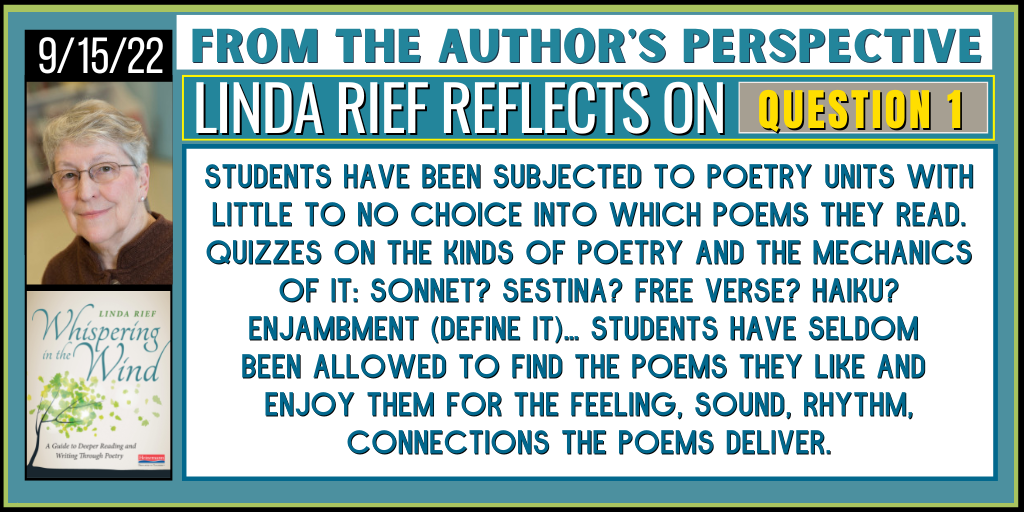
Q2 Penny Kittle writes in her endorsement, “This book is a master class in poetry, teaching writing, and joy.” How do you approach poetry in a way that will allow you to teach poetry writing while you also create an atmosphere of joy around it?
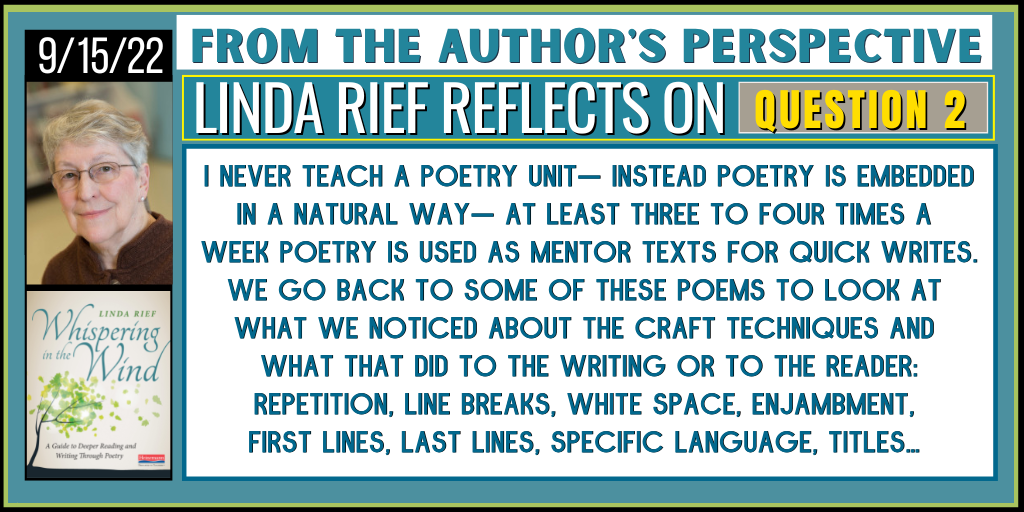
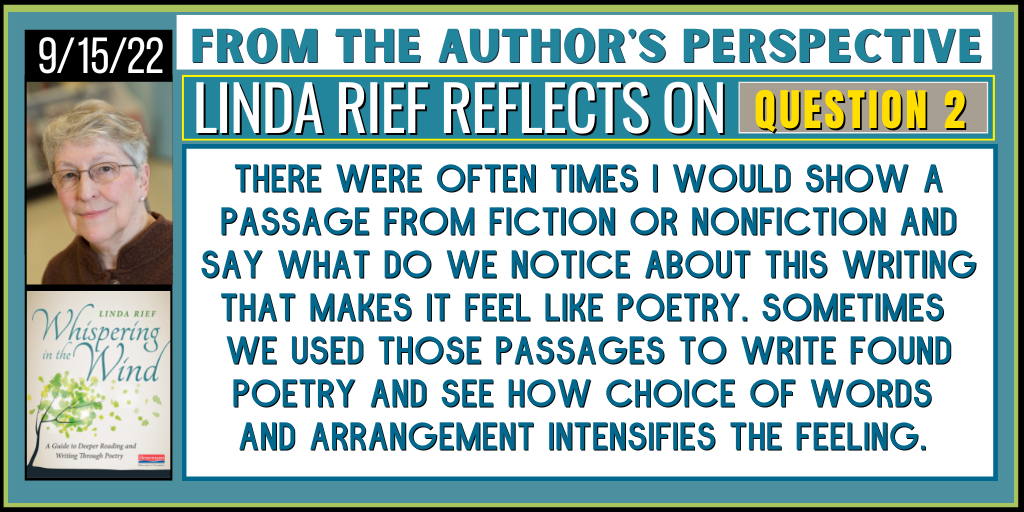
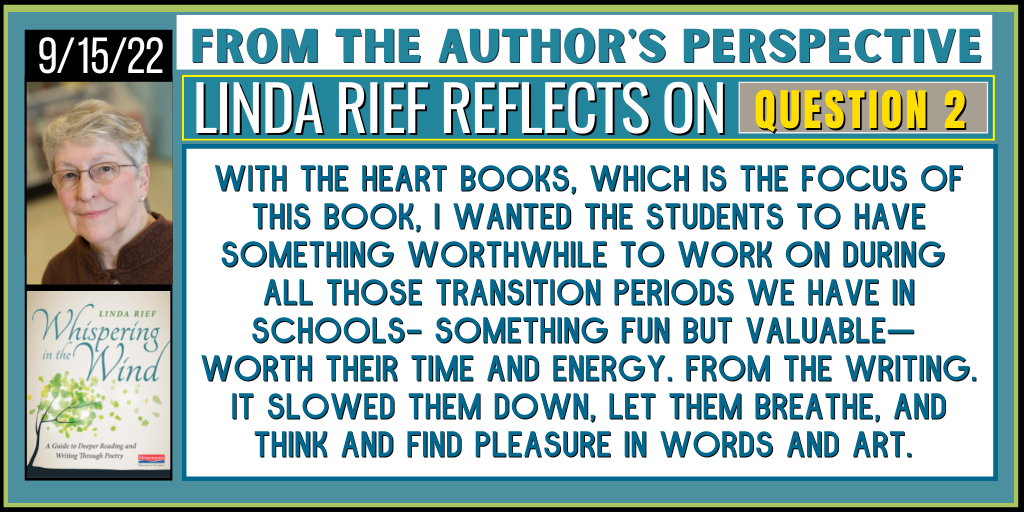
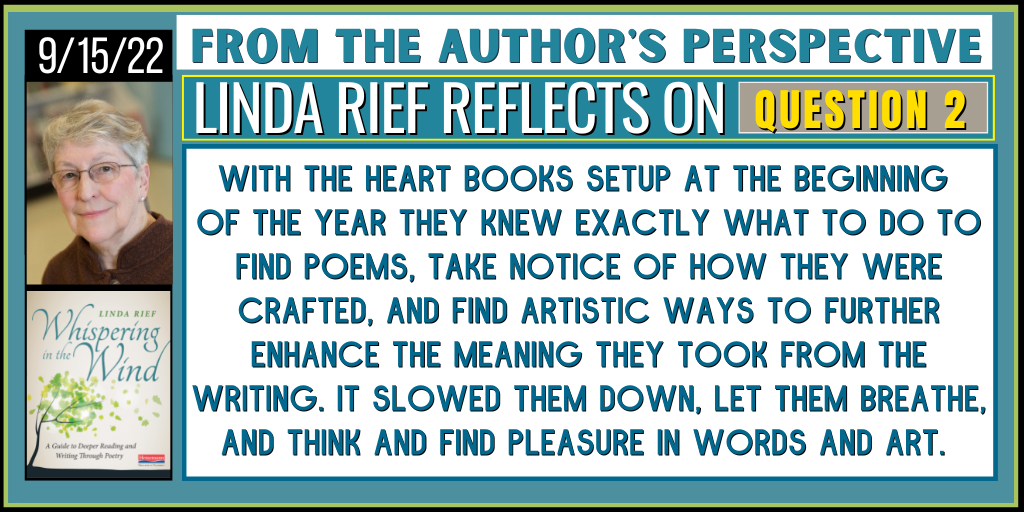
Q3 Linda reminds us on p. 156, “…students can do their best work when given choices, time, mentor texts, and positive responses that keep them growing stronger both intellectually and emotionally.” How do you nurture these things in your classroom?
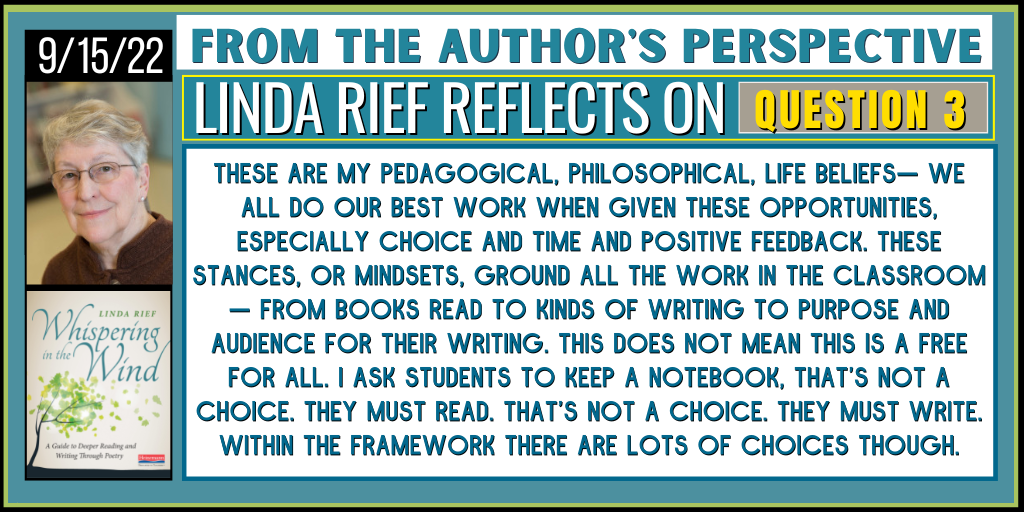
Q4 Linda emphasizes that in Heart Books, students “are responding to the poems they chose. Responding, not analyzing.” What do Linda’s words mean to you? How can this change their perception of poetry?

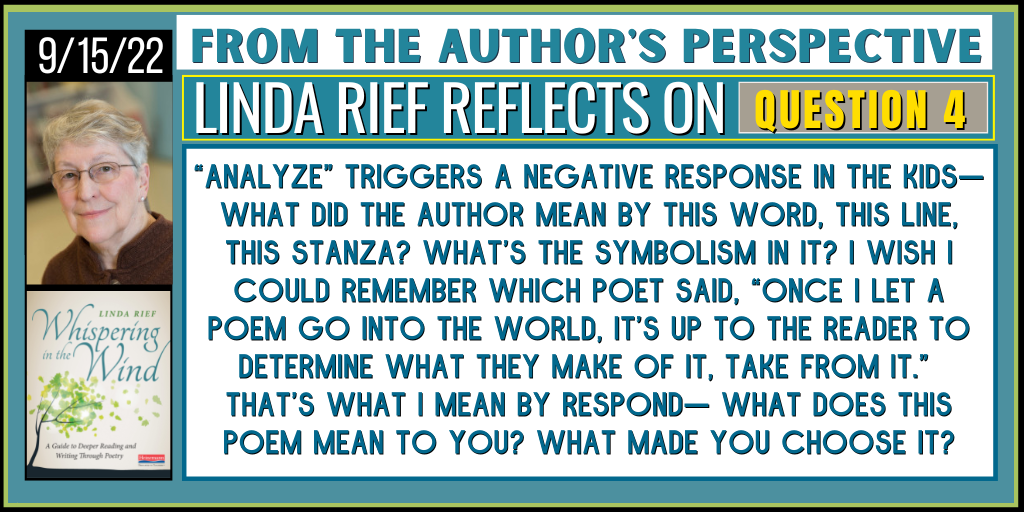
Q5 Linda says, “The more the students became involved in finding poems that spoke to them and spent time planning, playing with, and crafting their illustrations, the less the evaluation form mattered to them.” (pg 148) How will you bring Linda’s words to life this year?
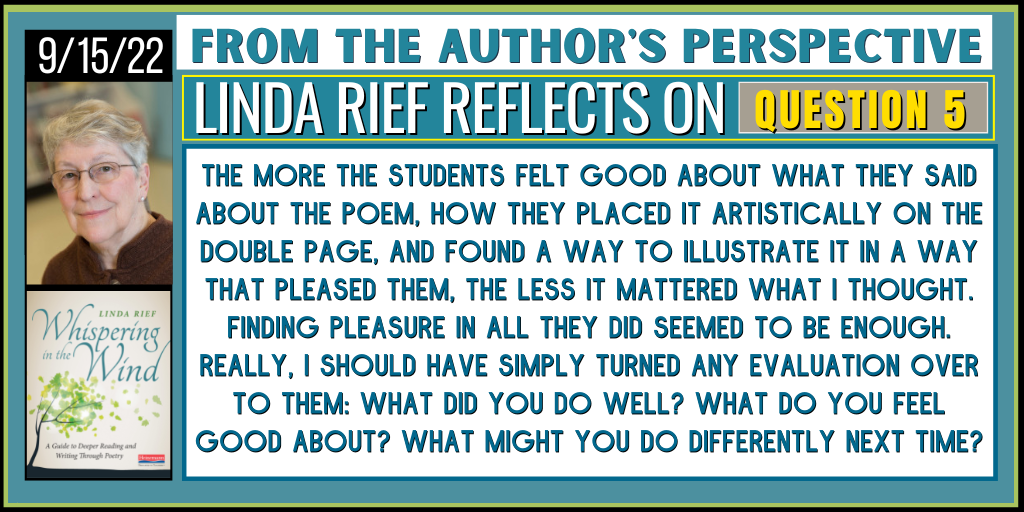
Q6 As we close our #G2Great discussion with Linda, what are some key takeaways that have inspired new thinking or ideas that you plan to translate into your teaching this year?
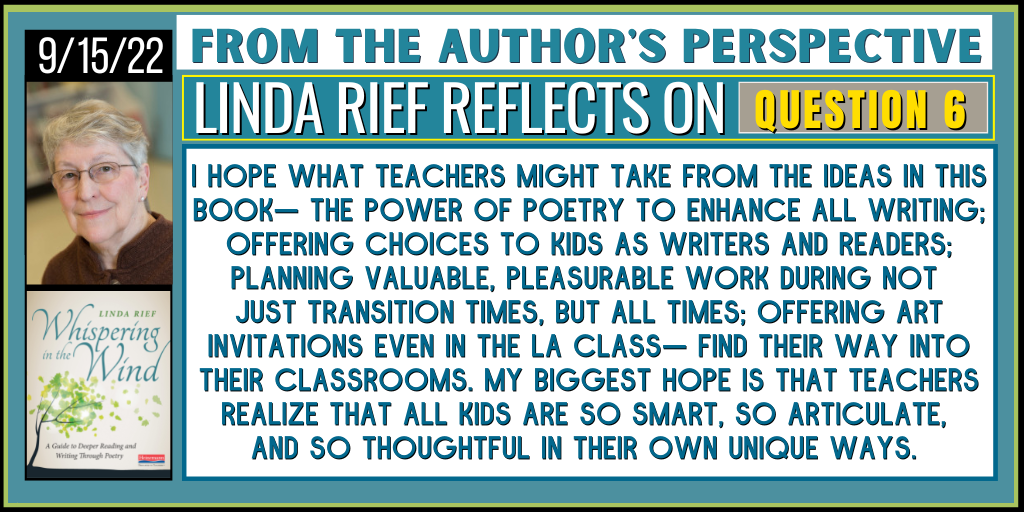
LINKS
Order Whispering in the Wind: A Guide to Deeper Reading and Writing Through Poetry by Linda Rief (Heinemann, 2022)
Blog post by Linda Rief: What Changes Kids’ Minds About Poetry? (Heinemann)